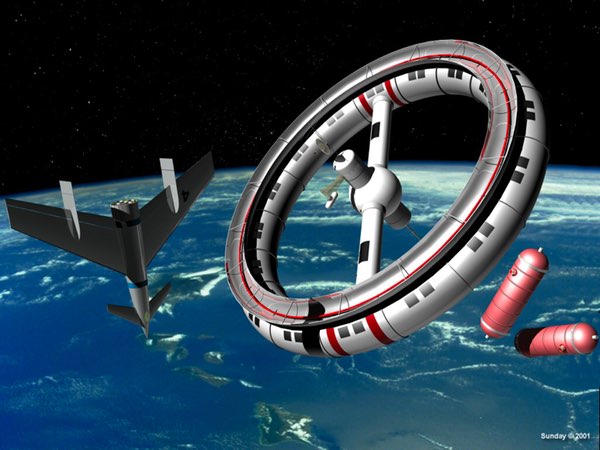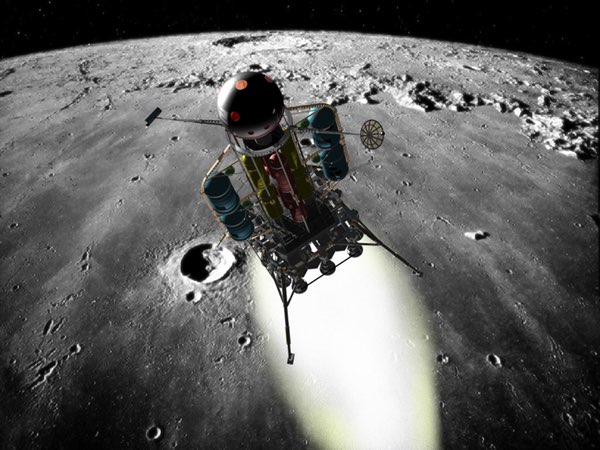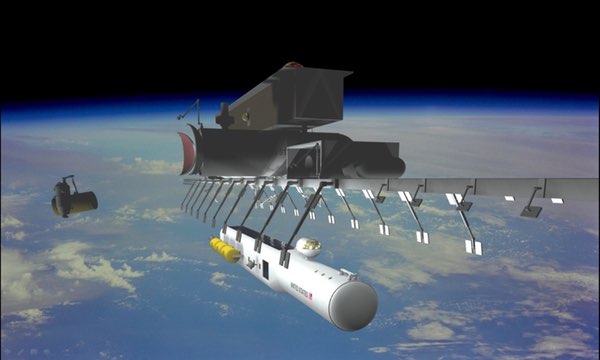Should NASA build spacefaring logistics infrastructure?by Mike Snead
|
| As the operational history of the Space Shuttle program shows, building and running a space railroad is not where NASA shines. |
For the past decade, I have been advocating that the United States needs to build an integrated spacefaring logistics infrastructure to enable it to undertake commercial space-based sustainable energy. A substantial part of my efforts has been explaining how such infrastructure, as illustrated above and in this short video, are not far-term concepts as most presume, but are now ready for engineering development and capability deployment.
Recently, some space advocates, such as Blue Origin founder Jeff Bezos, are now recognizing the need for spacefaring infrastructure, but are calling on this to be done by NASA. The purpose of this article is to explain why this should instead be done by a new federal government corporation established specifically to build and operate the required integrated spacefaring logistics infrastructure. NASA is an inappropriate choice to lead this effort. As the operational history of the Space Shuttle program shows, building and running a space railroad is not where NASA shines. As discussed below, there is much for NASA to do in pathfinding America’s transition into a commercial spacefaring nation concurrently with the building of this infrastructure.
Spacefaring logistics thinking in the 1950s
American space planners have long recognized the need to build an integrated spacefaring logistics infrastructure to enable routine human spacefaring operations to and beyond low Earth orbit (LEO). This thinking goes back to the early 1950s, when Wernher von Braun and other leading American space visionaries first started to describe these concepts. The two illustrations below, by space artist Terry Sunday, illustrate von Braun’s early concepts. The primary elements of such an infrastructure—reusable aircraft-like space access, LEO spaceports, and reusable spaceships to transit space—have been understood for 60 years.
 Reusable spaceplane and rotating wheel space station. (Credit: Terry Sunday, Digital Space Art; used with permission.) |
 Reusable lunar lander approaching the lunar surface. (Credit: Terry Sunday, Digital Space Art; used with permission.) |
As mentioned, some prominent space advocates are now calling for the Trump Administration to direct NASA to build spacefaring infrastructure. Perhaps, looking back to President Kennedy’s daring proposal to land a human on the Moon within the decade, these advocates seek a comparable dramatic proposal to have NASA build spacefaring logistics infrastructure. Is this a good idea? No, for reasons discussed below.
Infrastructure building is not central to NASA’s core mission
Infrastructure primarily serves and enhances commerce. At this time, there is no sound reason to build a spacefaring infrastructure primarily designed to support human space exploration, such as a science-focused lunar base or the first human Mars missions, as the 1950s infrastructure proposals were intended to support. Today, the need is for spacefaring infrastructure to enable new space-based sustainable energy, space mining, and space manufacturing industries to be built and operated. Building and operating this interplanetary industrial railroad does not fall within NASA’s core competencies and, in fact, conflicts with its primary science, technology development, and robotic and human exploration missions. NASA does not need the organizational and budgetary drama that such an undertaking would bring. The Space Shuttle program presented similar issues and building an operational infrastructure will be a much greater organizational challenge.
The coming space industrialization revolution
Having written in The Space Review last year about the clear national energy and environmental security needs for the United States to transition this century to space-based sustainable energy, I believe this will drive an immense American space industrialization revolution. Starting from scratch, by 2100 roughly 800 five-gigawatt space solar power platforms will need to be constructed in geosynchronous Earth orbit (GEO) for the United States to replace fossil fuels; for the world, this grows to 10,000 platforms. The two-gigawatt Hoover Dam was a remarkable American engineering success of the 1930s. For perspective, by 2100 the power generation equivalent of 25,000 Hoover Dams must be built in GEO for the world’s transition from fossil fuels to go smoothly and peacefully. That a space industrialization revolution will be needed to accomplish this major human civilization milestone is very apparent. That this will far overshadow, in the scale of human spacefaring operations, any human space exploration effort, is also quite apparent. Space industrialization will drive American non-military space policy and investment, both private and federal, for most of the rest of this century.
 View west over the Cacapon River Valley in West Virginia. (Credit: Mike Snead) |
National infrastructure is a federal responsibility
At the formal end of the American Revolutionary War in 1783, George Washington returned to Mount Vernon with the expectation of leading a quiet life of retirement. After eight years of warfare, he had certainly earned it. Yet, within months he became restless. Already quite familiar with western Virginia, he rode west, stopping on the journey at a mountaintop in today’s West Virginia looking west across the Cacapon River valley towards America’s new “frontier”—the Ohio Valley—beyond the distant hills. The view above is much as Washington saw it in 1784.
| And just as Washington recognized that infrastructure was needed to transit the Appalachian Mountains, America must now build an integrated spacefaring logistics infrastructure to climb out of Earth’s gravitational well. |
What Washington was seeking was a way to build infrastructure—portage roads and canals—to connect the Potomac and Ohio Rivers so that the vast untapped economic wealth of the Ohio River Valley, a key concession by Great Britain with the peace agreement, could flow to the new United States. Already, settlers were heading west in large numbers. In an agrarian society, land was wealth and the Ohio Valley had immense tracts of federal land that would be sold. Without infrastructure, however, it was impractical to establish easy commerce back east across the Appalachian Mountains. Instead, commerce was forced downriver to New Orleans, then Spanish territory. Washington and many other American leaders understood that it would be quite easy for the Ohio Valley to come under Spanish control, or even British control through Canada. Washington understood that infrastructure was the key to securing America’s western border.
Returning to Mount Vernon, he set to work to build infrastructure. He became the president of two canal companies with the intent of enabling canal boat travel up the Potomac. This effort failed because America then lacked the engineering expertise to undertake this effort. His infrastructure-building outreach effort to the other states was more successful. In part, this led to the 1787 Constitutional Convention, with Washington as its (somewhat reluctant) president, that wrote the current US Constitution. This constitution gave substantially more authority to a federal government, making this government responsible for regulating American interstate commerce and promoting the general welfare of the country.
These two new federal responsibilities became the centerpiece of American infrastructure building that began in the early 1800s. To move beyond a local agrarian society, America needed both intrastate and interstate commerce, which required the construction of infrastructure. Where there was no ready commercial market to justify private infrastructure investment—typical for opening a new physical or technological frontier—Congress often enabled the federal government to get the effort underway. The National Road to cross the mountains to the Ohio Valley was the start of these federal efforts.
Like the Ohio Valley in the late 1700s, there is an immense potential economic value to be created from space-based sustainable power. Like the situation with the Ohio Valley in Washington’s time, there is no current way to exploit this space economic value. And just as Washington recognized that infrastructure was needed to transit the Appalachian Mountains, America must now build an integrated spacefaring logistics infrastructure to climb out of Earth’s gravitational well, first to serve LEO, then, the entire Earth-Moon system, and, finally, the inner solar system. Only this will encourage and enable establishing American commercial space power, mining, and manufacturing industries. (For details on what this new infrastructure may entail, readers are referred to “Spacefaring Logistics Infrastructure: The Foundations of a Spacefaring America”.)
A spacefaring logistics federal government corporation is needed
I argue that the establishment and operation of this spacefaring logistics infrastructure must be overseen and regulated by the federal government to ensure acceptable safety, operability, and equitable private access as well as beneficial government utilization. Achieving this will best be accomplished through new public-private partnerships and commercial contracts undertaken by a new federal government corporation often referred to as a port authority. From the cited article:
For such large public works programs, a special authority, commission, or not-for-profit corporation is generally established to provide the necessary public oversight, planning direction, and financial control. Rather than assign the infrastructure development responsibility to an existing government agency, this approach has these advantages:
- The purpose, responsibilities, required operational capabilities, internal structure, implementation timeline, and public accountability can be clearly defined.
- A clear line of authority can be established and potential conflicts of interest or internal organizational competition for project funding, resources, and priorities can be avoided.
- A new budget line item for the organization can be created which helps to segregate needed public funding for the infrastructure effort from other governmental costs.
- The authority can be legally enabled to: issue bonds, in the name of the government, to raise the capital required for the development and construction of the infrastructure; to issue contracts for the construction and operation of the infrastructure; and, to raise revenue to help retire the incurred debt.
- The authority can be staffed by people whose primary motivation is to successfully build and operate the infrastructure rather than being internally reassigned to undertake a task of which they may have little personal interest.
| Infrastructure needs to be well organized to operate with acceptable safety, efficiency, and effectiveness. As with major past American infrastructure programs, like the Panama Canal and the Interstate Highway System, the federal government needs to now take the helm. |
In the new Trump Administration, getting this spacefaring infrastructure ball rolling will require two steps. First, a national sustainable energy security policy is needed to identify space-based sustainable energy as the nation’s primary means of transitioning from fossil fuels and ending fossil fuel carbon emissions. This establishes the need for space industrialization and, consequently, for an integrated spacefaring logistics infrastructure. And, second, introduce legislation to establish a new federal government corporation, perhaps generally modeled after the Tennessee Valley Authority, to create and oversee the commercial operation of an integrated American spacefaring logistics infrastructure.
What’s in this for NASA?
Building 10,000 space-based sustainable energy platforms by 2100 will require space mining and space manufacturing, as well as the ability to conduct acceptably-safe and routine commercial human operations throughout the central solar system. Just as happened with the emergence of commercial aviation and, especially, jet-powered aviation, the federal government will need to take a proactive role to lead the development of critical-path technologies and to undertake pathfinding human space exploration missions as a precursor for follow-on commercial space operations on the Moon and throughout the central solar system. This is NASA’s cup of tea, so to speak. The Orion spacecraft and the Space Launch System will provide the initial capabilities NASA will need to get back to the Moon to start this process. While NASA scientists will certainly undertake science missions as part of these efforts—perhaps even using the new infrastructure to support a manned Mars mission—a significant part of their efforts will be helping American industry develop the industrial mastery needed to mass-produce GEO power platforms in space from extraterrestrial resources.
Conclusion
As the Trump Administration begins, America is now in a very good position technologically to begin to build the spacefaring logistics infrastructure needed to become a true spacefaring nation. America has the ability to build fully-reusable, airworthiness-certified passenger space access and in-space transportation systems, and to deploy a substantial initial infrastructure in LEO. Undertaking these in a hodgepodge manner through disconnected private enterprise efforts will not be successful. Infrastructure needs to be well organized to operate with acceptable safety, efficiency, and effectiveness. As with major past American infrastructure programs, like the Panama Canal and the Interstate Highway System, the federal government needs to now take the helm. Specifically, a new federal government corporation should be established to lead both government and private enterprise spacefaring logistics infrastructure efforts.
